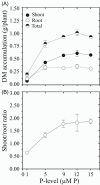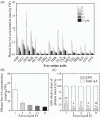Growth and nodulation of symbiotic Medicago truncatula at different levels of phosphorus availability
- PMID: 23682114
- PMCID: PMC3697940
- DOI: 10.1093/jxb/ert122
Growth and nodulation of symbiotic Medicago truncatula at different levels of phosphorus availability
Abstract
Medicago truncatula is an important model plant for characterization of P deficiency on leguminous plants at the physiological and molecular levels. Growth optimization of this plant with regard to P supply is the first essential step for elucidation of the role of P in regulation of nodulation. Hence, a study was carried out to address the growth pattern of M. truncatula hydroponically grown at different gradual increases in P levels. The findings revealed that M. truncatula had a narrow P regime, with an optimum P level (12 μM P) which is relatively close to the concentration that induces P toxicity. The accumulated P concentration (2.7 mg g(-1) dry matter), which is normal for other crops and legumes, adversely affected the growth of M. truncatula plants. Under P deficiency, M. truncatula showed a higher symbiotic efficiency with Sinorhizobium meliloti 2011 in comparison with S. meliloti 102F51, partially as a result of higher electron allocation to N2 versus H(+). The total composition of free amino acids in the phloem was significantly affected by P deprivation. This pattern was found to be almost exclusively the result of the increase in the asparagine level, suggesting that asparagine might be the shoot-derived signal that translocates to the nodules and exerts the down-regulation of nitrogenase activity. Additionally, P deprivation was found to have a strong influence on the contents of the nodule carbon metabolites. While levels of sucrose and succinate tended to decrease, a higher accumulation of malate was observed. These findings have provided evidence that N2 fixation of M. truncatula is mediated through an N feedback mechanism which is closely related to nodule carbon metabolism.
Keywords: Asparagine; Medicago truncatula; carbon and nitrogen metabolites; feedback; nitrogen fixation; nitrogenase activity; nodulation; phloem; phosphorus availability; plant growth; symbiosis capacity; translocation..
Figures






Similar articles
-
N-feedback regulation is synchronized with nodule carbon alteration in Medicago truncatula under excessive nitrate or low phosphorus conditions.J Plant Physiol. 2014 Mar 15;171(6):407-10. doi: 10.1016/j.jplph.2013.12.006. Epub 2014 Feb 14. J Plant Physiol. 2014. PMID: 24594392
-
Overexpression of the arginine decarboxylase gene promotes the symbiotic interaction Medicago truncatula-Sinorhizobium meliloti and induces the accumulation of proline and spermine in nodules under salt stress conditions.J Plant Physiol. 2019 Oct;241:153034. doi: 10.1016/j.jplph.2019.153034. Epub 2019 Aug 27. J Plant Physiol. 2019. PMID: 31493718
-
Phosphorous deficiency decreases nitrogenase activity but increases proton efflux in N2-fixing Medicago truncatula.Plant Physiol Biochem. 2011 Apr;49(4):458-60. doi: 10.1016/j.plaphy.2011.01.022. Epub 2011 Feb 1. Plant Physiol Biochem. 2011. PMID: 21334214
-
Investigating biological nitrogen fixation via single-cell transcriptomics.J Exp Bot. 2025 Feb 25;76(4):931-949. doi: 10.1093/jxb/erae454. J Exp Bot. 2025. PMID: 39563004 Free PMC article. Review.
-
NPF and NRT2 from Pisum sativum Potentially Involved in Nodule Functioning: Lessons from Medicago truncatula and Lotus japonicus.Plants (Basel). 2024 Jan 22;13(2):322. doi: 10.3390/plants13020322. Plants (Basel). 2024. PMID: 38276779 Free PMC article. Review.
Cited by
-
Organic Nitrogen-Driven Stimulation of Arbuscular Mycorrhizal Fungal Hyphae Correlates with Abundance of Ammonia Oxidizers.Front Microbiol. 2016 May 12;7:711. doi: 10.3389/fmicb.2016.00711. eCollection 2016. Front Microbiol. 2016. PMID: 27242732 Free PMC article.
-
Spatial Divergence of PHR-PHT1 Modules Maintains Phosphorus Homeostasis in Soybean Nodules.Plant Physiol. 2020 Sep;184(1):236-250. doi: 10.1104/pp.19.01209. Epub 2020 Jul 17. Plant Physiol. 2020. PMID: 32680974 Free PMC article.
-
Innovation and appropriation in mycorrhizal and rhizobial Symbioses.Plant Cell. 2022 Apr 26;34(5):1573-1599. doi: 10.1093/plcell/koac039. Plant Cell. 2022. PMID: 35157080 Free PMC article.
-
Stoichiometric homeostasis of N:P ratio drives species-specific symbiotic N fixation inhibition under N addition.Front Plant Sci. 2023 Apr 26;14:1076894. doi: 10.3389/fpls.2023.1076894. eCollection 2023. Front Plant Sci. 2023. PMID: 38487209 Free PMC article.
-
Patterns of Growth Costs and Nitrogen Acquisition in Cytisus striatus (Hill) Rothm. and Cytisus balansae (Boiss.) Ball are Mediated by Sources of Inorganic N.Plants (Basel). 2016 Apr 16;5(2):20. doi: 10.3390/plants5020020. Plants (Basel). 2016. PMID: 27135240 Free PMC article.
References
-
- Almeida JPF, Hartwig UA, Frehner M, Nösberger J, Lüscher A. 2000. Evidence that P deficiency induces N feedback regulation of symbiotic N2 fixation in white clover (Trifolium repens L.). Journal of Experimental Botany 51, 1289–1297. - PubMed
-
- Bacanamwo M, Harper JE. 1997. The feedback mechanism of nitrate inhibition of nitrogenase activity in soybean may involve asparagine and/or products of its metabolism. Physiologia Plantarum 100, 371–377.
-
- Bell RW, Edwards DG, Asher CJ. 1990. Growth and nodulation of tropical food legumes in dilute solution culture. Plant and Soil 122, 249–258.
Publication types
MeSH terms
Substances
LinkOut - more resources
Full Text Sources
Other Literature Sources

